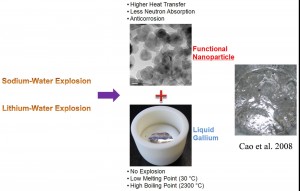Safety and economic feasibility
After the Fukushima accident, the concerns on nuclear safety are increasing more than ever before. In particular, promising coolants for fast neutron reactors start to become major targets to the nuclear safety issues. Liquid metals such as sodium, sodium–potassium, lead, and lead–bismuth, as well as gallium have been considered as potential coolants in fast reactors. Among them, gallium is in the liquid state even under room temperature, has the lowest melting point (∼30 °C) and has no explosive reaction with water. However, liquid gallium has a lower thermal conductivity than other liquid metals such as sodium. If nanoparticles were evenly dispersed in liquid gallium, having the higher conductivity the suspended nanoparticles would be expected to produce a highly thermal-conductive coolant for nuclear applications without any safety concerns. At least, it would be promising to adopt the coolant in a safety system like passive decay heat removal system. The present work investigates the feasibility of using liquid gallium with nanoparticles in nuclear applications. The key issue of the original idea is whether a stable dispersion can be achieved with various nanoparticles having high thermal conductivities. In the study, the results show that good dispersion stability can be obtained by controlling shear rates based on centrifugal forces.
(a) Al2O3/liquid gallium mixture, (b) Al2O3/liquid gallium nanofluid, (c) SiC/liquid gallium mixture, (d) SiC/liquid gallium nanofluid, (e) TOF-SIMS analysis of Al2O3/liquid gallium nanofluid, and (f) TOF-SIMS analysis of SiC/liquid gallium nanofluid




